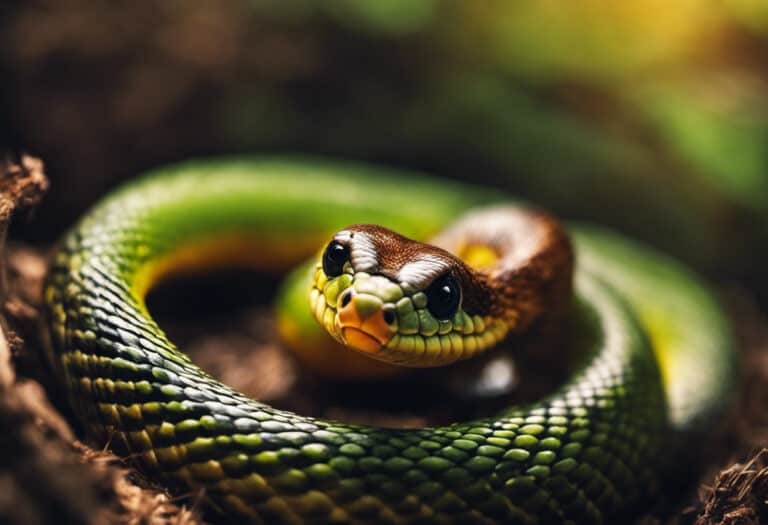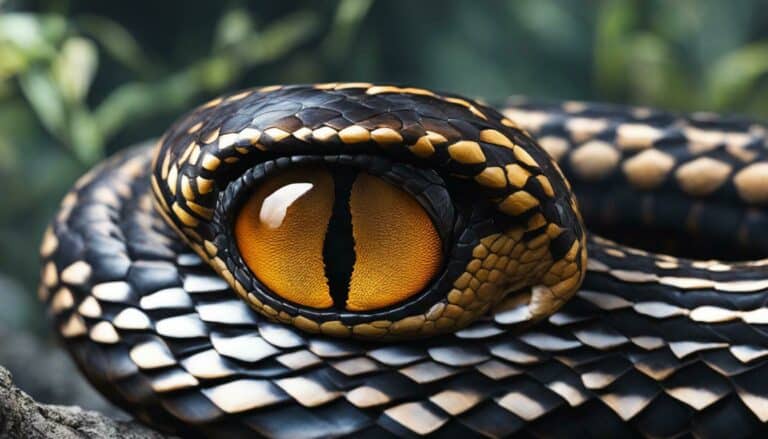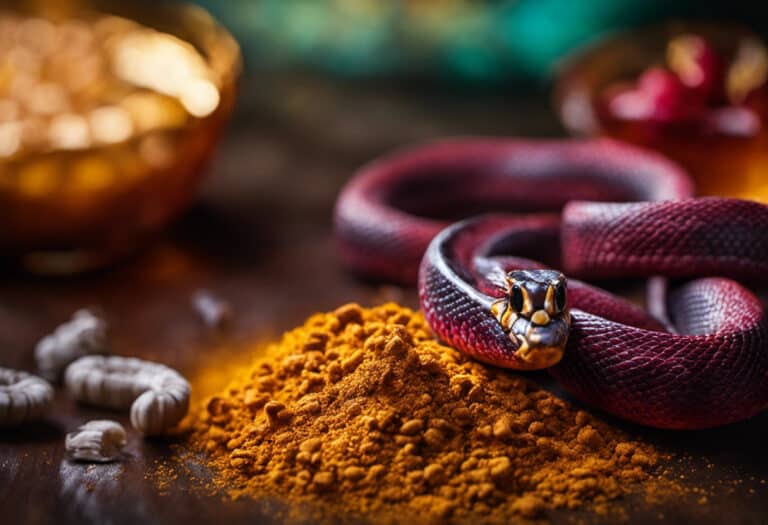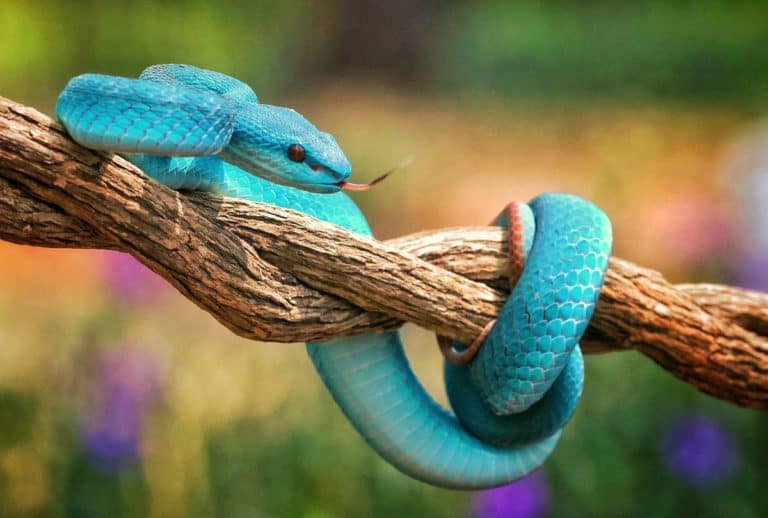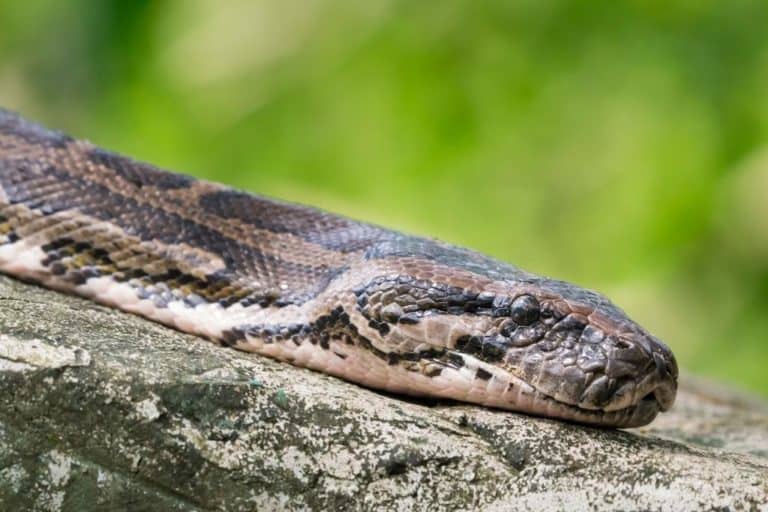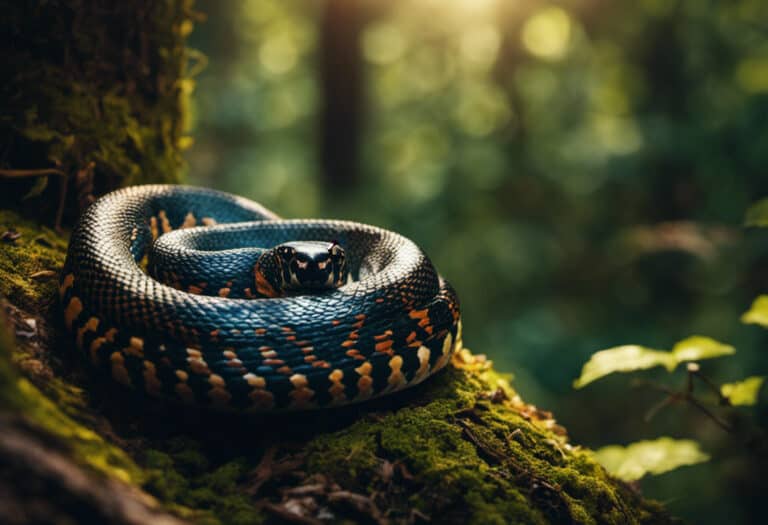Can Corn Snakes Eat Fish?
Are you ready to dive into the world of alternative food sources for your corn snake? If so, let’s explore the intriguing question: Can corn snakes eat fish?
You may have wondered if fish could be a suitable addition to your pet’s diet. In this article, we will delve into the potential benefits of incorporating fish into their meals. We’ll cover safe fish options, proper preparation methods, feeding frequency, and more.
Get ready to broaden your snake’s palate and discover new possibilities!
Key Takeaways
- Fish can be a suitable alternative to frozen/thawed mice for corn snakes.
- Offering a variety of fish can help stimulate the snake’s appetite.
- Guppies, goldfish, minnows, and silversides are suitable types of fish for corn snakes.
- It is important to properly prepare the fish and monitor the snake during feeding.
The Suitability of Fish as a Food Source for Corn Snakes
Fish can provide essential nutrients for your corn snake, making them a suitable alternative to frozen/thawed mice. While corn snakes are primarily fed mice, introducing fish into their diet can offer a variety of benefits.
Some corn snakes may show interest in eating fish, and they can provide essential nutrients that contribute to the overall health of the snake.
However, it’s important to note that fish shouldn’t be the primary diet for corn snakes. Instead, they should be offered as occasional treats or to stimulate the snake’s appetite.
When choosing fish, it’s crucial to select safe and appropriate options such as guppies, goldfish (in moderation), minnows from reputable suppliers, silversides for larger corn snakes, and possibly small trout or salmon.
Always ensure the fish is properly thawed, remove any bones or sharp parts, and monitor the snake during feeding to ensure proper swallowing.
It’s recommended to consult a reptile veterinarian for specific feeding guidelines for your corn snake.
Factors to Consider When Offering Fish to Corn Snakes
To ensure a successful transition to a fish-based diet for your corn snake, it’s important to consider factors such as the size and type of fish you offer. Fish can be a suitable alternative to frozen/thawed mice for corn snakes, providing essential nutrients and stimulating their appetite.
Popular choices include guppies, which are small and easy to digest, and goldfish can be fed occasionally but shouldn’t be the main diet. Minnows from reputable suppliers and silversides are also suitable options, while some corn snakes may accept small trout or salmon.
Prior to feeding, thaw the fish, remove any bones or sharp parts, and consider gut-loading the fish with nutrients. Offer the fish live or pre-killed, monitoring the snake during feeding to ensure proper swallowing.
Feeding frequency and portion sizes should be appropriate for the snake’s age and size to prevent obesity. It’s normal for snakes to go through periods of refusing food, but if the snake consistently refuses fish, consult a reptile veterinarian.
Types of Fish That Corn Snakes Can Safely Consume
When considering fish as a food source for your corn snake, it’s important to choose types that are safe and appropriate.
Guppies are a popular choice due to their small size and easy digestibility.
Goldfish can be fed occasionally, but shouldn’t be the main diet.
Minnows and silversides are also suitable options, while some corn snakes may accept small trout or salmon.
Fish Nutrition for Snakes
If you choose to feed your corn snake fish, it’s important to provide them with a variety of species for a balanced diet. Fish can be a suitable alternative to frozen/thawed mice for corn snakes, and they can provide essential nutrients. Offering a variety of fish can help stimulate the snake’s appetite.
Guppies are a popular choice as they’re small and easy to digest. Goldfish can be fed occasionally, but shouldn’t be the main diet. Minnows are another option, but they should be sourced from reputable suppliers. Silversides are a good choice for larger corn snakes. Some corn snakes may also accept small trout or salmon.
Fish should be properly thawed and any bones or sharp parts should be removed. It’s recommended to gut-load the fish with appropriate nutrients. Fish can be offered live or pre-killed depending on the snake’s preference.
Feeding frequency and portion sizes should be appropriate for the snake’s age and size. Always monitor the snake during feeding to ensure it swallows the fish properly.
Some corn snakes may readily accept fish as a food source, while others may need time to adjust. If the snake consistently refuses fish, it may be necessary to consult a reptile veterinarian.
Safe Fish Options
Guppies, goldfish, minnows, silversides, and small trout or salmon are safe options for your corn snake’s diet.
Incorporating fish into their diet can provide several benefits for your snake. Fish are a suitable alternative to frozen/thawed mice and can offer essential nutrients to ensure your snake’s overall health.
To prepare the fish, it’s important to properly thaw them and remove any bones or sharp parts that could pose a choking hazard.
Gut-loading the fish with appropriate nutrients before feeding is recommended. Whether offering live or pre-killed fish depends on your snake’s preference. Always monitor the snake during feeding to ensure it swallows the fish properly.
When considering portion sizes, younger corn snakes may require smaller fish and more frequent feedings, while adult corn snakes can be fed larger fish less frequently. It’s crucial not to overfeed your snake to prevent obesity and health issues.
Observe your snake’s response to the fish diet, as some may readily accept it while others may take time to adjust. If your snake consistently refuses fish, consulting a reptile veterinarian is recommended.
Feeding Considerations and Techniques
When considering feeding fish to your corn snake, it’s important to be mindful of certain considerations and techniques.
First, fish should be properly thawed before offering them to the snake to ensure easy digestion. It’s also crucial to remove any bones or sharp parts that could pose a choking hazard.
To provide essential nutrients, gut-loading the fish with appropriate nutrients before feeding is recommended.
Depending on your snake’s preference, fish can be offered live or pre-killed. Always monitor the snake during feeding to ensure it swallows the fish properly.
Feeding fish to corn snakes can have several benefits. Fish can be a suitable alternative to frozen/thawed mice, and some corn snakes may show interest in eating fish.
Fish can provide essential nutrients for corn snakes, and offering a variety of fish can help stimulate their appetite.
However, it’s important to choose fish that are safe and appropriate for corn snakes.
Proper Preparation of Fish for Feeding Corn Snakes
To ensure the safety and health of your corn snake, it’s important to properly thaw and remove any bones or sharp parts from the fish before offering it as a meal. Fish can be a suitable alternative to frozen/thawed mice for corn snakes, providing essential nutrients and stimulating their appetite.
Guppies, goldfish, minnows, silversides, and small trout or salmon are all suitable choices. When preparing fish, make sure to thoroughly thaw them and remove any potential choking hazards. Gut-loading the fish with appropriate nutrients before feeding is also recommended.
Depending on your snake’s preference, you can offer the fish live or pre-killed. Monitor your snake during feeding to ensure it swallows the fish properly. Remember to feed your corn snake fish in appropriate portion sizes and consult a reptile veterinarian for specific feeding guidelines.
Feeding Frequency and Portion Sizes for Corn Snakes
When it comes to feeding your corn snake fish, it’s important to consider the feeding frequency and portion sizes to ensure their health and well-being.
The feeding frequency should be based on the snake’s age and size. Young corn snakes may require more frequent feedings, while adult corn snakes can be fed less frequently. It’s crucial to avoid overfeeding to prevent obesity and related health issues.
As for portion sizes, they should be appropriate for the snake’s size. Smaller fish should be given to younger snakes, while larger fish can be offered to adult snakes.
Consulting a reptile veterinarian for specific feeding guidelines for your corn snake is highly recommended.
Monitoring the Snake’s Response to Fish as Food
As you introduce fish as a potential food source for corn snakes, it’s crucial to monitor the snake’s response to this new diet. Pay close attention to the snake’s acceptance of fish, noting whether it readily consumes the food or exhibits hesitation.
Additionally, observe the snake’s consistency in refusing food, as this may indicate a need for further investigation or consultation with a reptile veterinarian.
Acceptance of Fish
If your corn snake shows interest in eating fish, it can be a suitable alternative to frozen/thawed mice and provide essential nutrients. Encouraging appetite in corn snakes can sometimes be a challenge, but offering fish as a food source can help stimulate their interest.
When troubleshooting issues with feeding, it’s important to choose fish that are safe and appropriate for corn snakes. Guppies are a popular choice as they’re small and easy to digest. Goldfish can be fed occasionally, but they shouldn’t be the main diet. Minnows and silversides are also good options, but they should be sourced from reputable suppliers.
Preparing the fish involves thawing them properly, removing any bones or sharp parts, and gut-loading them with nutrients. Always monitor the snake during feeding to ensure it swallows the fish properly. Remember to consult a reptile veterinarian for specific feeding guidelines for your corn snake.
Adaptation to New Diet
You may notice your snake’s behavior and appetite changing as it adapts to the new diet. Here are three ways to encourage adaptation and overcome reluctance when feeding fish to your corn snake:
-
Gradual Introduction: Start by offering small pieces of fish alongside their regular diet of mice. This allows the snake to become familiar with the new scent and taste of fish without completely removing their staple food.
-
Scent Enhancement: To make the fish more enticing, you can try scenting it with the smell of mice. Rubbing the fish with a thawed mouse or its bedding can help simulate the familiar scent and increase the snake’s interest.
-
Patience and Persistence: Some corn snakes may take time to adjust to the new diet. Be patient and continue offering fish regularly. It may take several attempts before your snake fully accepts fish as a food source.
Consistency in Refusing Food?
If your corn snake consistently refuses food, it can be concerning and may require further attention. Encouraging appetite in corn snakes can be a delicate process, but it’s important to address any health concerns that may be causing the refusal.
Start by ensuring that the snake’s enclosure is properly set up with appropriate temperature and humidity levels. Stress can also contribute to a decreased appetite, so providing a secure and peaceful environment is crucial.
Offering a variety of food options, such as different types of fish, can help stimulate the snake’s appetite. However, if the refusal persists or if you notice any other symptoms of illness, it’s advisable to consult a reptile veterinarian for a thorough examination and appropriate treatment.
Tips for Encouraging Corn Snakes to Eat Fish
Encourage your corn snake to eat fish by offering a variety of safe and appropriate options.
-
Introduce variety: Corn snakes can become bored with a monotonous diet, so offering different types of fish can help stimulate their appetite.
-
Choose safe options: Opt for small and easily digestible fish like guppies or minnows. Avoid feeding goldfish as their high fat content can be detrimental to the snake’s health.
-
Gut-load the fish: Before feeding, provide the fish with appropriate nutrients to ensure your corn snake receives a balanced diet.
By encouraging appetite and introducing variety, you can entice your corn snake to eat fish as an alternative food source.
Remember to monitor your snake during feeding and consult a reptile veterinarian for specific feeding guidelines.
Potential Challenges When Feeding Corn Snakes Fish
Feeding fish to corn snakes may present challenges due to their potential hesitation or adjustment period to the new diet.
Some corn snakes may readily accept fish as a food source, while others may be more hesitant and require some time to adjust. It’s important to be aware that corn snakes may go through periods of refusing food, and this is normal. However, if the snake consistently refuses fish, it may be necessary to troubleshoot the feeding technique.
One potential challenge is finding the right type of fish that’s safe and appropriate for corn snakes. Guppies are a popular choice as they’re small and easy to digest, while larger corn snakes may accept silversides or small trout.
Another challenge is preparing the fish properly, ensuring they’re thawed, gut-loaded with nutrients, and free from any bones or sharp parts that could pose a choking hazard.
Additionally, monitoring the snake during feeding is crucial to ensure that it swallows the fish properly. If you encounter difficulties with fish feeding, consulting a reptile veterinarian can provide guidance and assistance.
Consulting a Reptile Veterinarian for Feeding Guidelines
You should consult a reptile veterinarian for specific feeding guidelines tailored to your corn snake. They can provide expert advice on fish feeding concerns and help ensure the health and well-being of your snake. Here are three reasons why consulting a reptile veterinarian is important:
-
Expertise: Reptile veterinarians have specialized knowledge and experience in caring for corn snakes. They can provide you with accurate information on the nutritional needs of your snake and guide you on the appropriate types and sizes of fish to feed.
-
Individualized Guidance: Every corn snake is unique, and their dietary requirements may vary. A reptile veterinarian can assess your snake’s specific needs, taking into account factors like age, size, and overall health, and provide personalized feeding recommendations.
-
Preventing Health Issues: Feeding your corn snake fish requires careful consideration to ensure a balanced diet and prevent any potential health problems. Reptile veterinarians can advise you on proper fish preparation, feeding frequency, and portion sizes to promote optimal health and prevent obesity or nutritional deficiencies.
Frequently Asked Questions
Can Corn Snakes Eat Fish as Their Primary Diet?
Yes, corn snakes can eat fish as an alternative food option. Fish can provide essential nutrients and stimulate their appetite. However, it is important to choose safe and appropriate fish, offer variety, and monitor feeding to ensure proper swallowing.
How Often Should I Feed My Corn Snake Fish?
Feeding your corn snake fish can be a great alternative to their regular diet. The frequency of feeding will depend on their age and size. Consult a vet for specific guidelines. Enjoy exploring new food options for your scaly friend!
Are There Any Risks or Challenges Associated With Feeding Corn Snakes Fish?
Feeding corn snakes fish can pose some risks and challenges. Potential risks include choking hazards from bones and sharp parts, and the challenge of finding safe and appropriate fish species. It’s important to monitor the snake’s response and consult a reptile veterinarian for guidance.
How Can I Encourage My Corn Snake to Eat Fish if It Is Hesitant?
To encourage your corn snake to eat fish, try offering a variety of fish types and sizes. Thaw the fish properly, remove any bones, and monitor the snake during feeding. Consult a reptile veterinarian for specific guidelines.
When Should I Consult a Reptile Veterinarian Regarding Feeding Guidelines for My Corn Snake?
If you have concerns about feeding guidelines for your corn snake, it’s wise to consult a reptile veterinarian. They have the expertise to provide specific guidance based on your snake’s age, size, and health.
Conclusion
In conclusion, while fish may seem like an intriguing alternative food source for corn snakes, it’s essential to consider various factors before incorporating it into their diet.
The types of fish that are safe and appropriate, proper preparation methods, and monitoring the snake’s response are crucial aspects to consider. Additionally, consulting a reptile veterinarian for feeding guidelines can help ensure the health and well-being of your corn snake.
So, before diving into the world of fish as a food source, it’s important to thoroughly research and make informed decisions for your pet snake.
